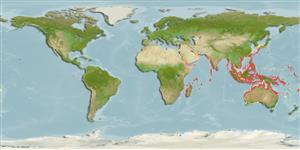Common names from other countries
Classification / Names / Names
Nomi Comuni | Sinonimi | Catalog of Fishes (gen., sp.) | ITIS | CoL | WoRMS
Environment: milieu / climate zone / depth range / distribution range
Ecologia
; distribuzione batimetrica 0 - 30 m (Ref. 101024). Tropical
Indo-West Pacific: from East Africa to eastern Melanesia; north to Japan and south to southern Queensland and New Caledonia.
Length at first maturity / Size / Peso / Age
Maturity: Lm ? range ? - ? cm Max length : 4.0 cm SHL maschio/sesso non determinato; (Ref. 349); common length : 3.0 cm SHL maschio/sesso non determinato; (Ref. 349)
Mainly collected for its shell; common (Ref. 349). Minimum depth assumed from its ecology. It is found in littoral (Ref. 128042), and shallow subtidal zones. Burrows in sand flats (Refs. 349, 128042). On dark sands at night (Ref. 799). In general, members of the family Olividae are carnivores (Ref. 67623).
Life cycle and mating behavior
Maturità | Riproduzione | Deposizione | Uova | Fecundity | Larve
This species is a non-broadcast spawner. Life cycle does not include trocophore stage. Also Ref. 833.
Poutiers, J.M. 1998. (Ref. 349)
IUCN Red List Status (Ref. 130435)
CITES status (Ref. 108899)
Not Evaluated
Not Evaluated
Threat to humans
Harmless
Human uses
| FishSource |
Strumenti
Informazioni ulteriori
Age/SizeAccrescimentoLength-weightLength-lengthMorfologiaLarveAbbondanza
Fonti Internet
Estimates based on models
Preferred temperature
(Ref.
115969): 24.7 - 29.3, mean 28.5 (based on 3287 cells).
Vulnerability
Low vulnerability (10 of 100).
Price category
Unknown.
